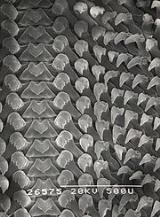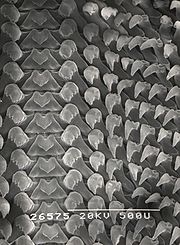
Aplysia juliana
Encyclopedia
Aplysia juliana, common name
the walking sea hare, is a species
of sea slug
, more specifically a sea hare
, a marine
gastropod mollusk in the family Aplysiidae
, the sea hares.
, circumtropical in all warm seas.
 This sea hare has no purple gland and therefore cannot produce ink, just milky secretions. The posterior end of the foot in this species can act as a sucker.
This sea hare has no purple gland and therefore cannot produce ink, just milky secretions. The posterior end of the foot in this species can act as a sucker.
The color of this sea hare is very often brown with paler spots, but it can be various other shades including plain black all over.
The maximum recorded length is 300 mm.
Common name
A common name of a taxon or organism is a name in general use within a community; it is often contrasted with the scientific name for the same organism...
the walking sea hare, is a species
Species
In biology, a species is one of the basic units of biological classification and a taxonomic rank. A species is often defined as a group of organisms capable of interbreeding and producing fertile offspring. While in many cases this definition is adequate, more precise or differing measures are...
of sea slug
Sea slug
Sea slug is a common name used for several different groups of saltwater snails that either lack a shell or have only an internal shell, in other words this name is used for various lineages of marine gastropod mollusks that are either not conchiferous or appear not to be.The phrase "sea slug" is...
, more specifically a sea hare
Sea hare
The clade Aplysiomorpha, commonly known as Sea hares or Sea Bags , are medium-sized to very large Opisthobranchia with a soft internal shell made of protein...
, a marine
Marine (ocean)
Marine is an umbrella term. As an adjective it is usually applicable to things relating to the sea or ocean, such as marine biology, marine ecology and marine geology...
gastropod mollusk in the family Aplysiidae
Aplysiidae
The superfamily Aplysioidea is a superfamily of mostly rather large sea slugs, marine gastropod mollusks in the clade Aplysiomorpha within the informal group Opisthobranchia.This superfamily contains only one family, the Aplysiidae; the sea hares...
, the sea hares.
Distribution
Distribution of this species is cosmopolitanCosmopolitan distribution
In biogeography, a taxon is said to have a cosmopolitan distribution if its range extends across all or most of the world in appropriate habitats. For instance, the killer whale has a cosmopolitan distribution, extending over most of the world's oceans. Other examples include humans, the lichen...
, circumtropical in all warm seas.
Description

The color of this sea hare is very often brown with paler spots, but it can be various other shades including plain black all over.
The maximum recorded length is 300 mm.
External links
- http://www.seaslugforum.net/display.cfm?id=10355

